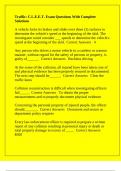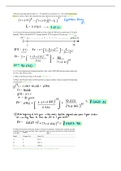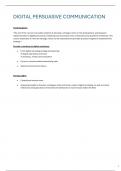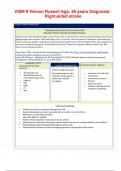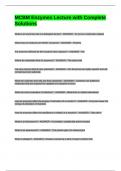UNISA 2024 ECS1601-24-Y Online assessments Assessment 6
QUIZ
Started on Wednesday, 9 October 2024, 1:00 PM
State Finished
Completed on Wednesday, 9 October 2024, 1:31 PM
Time taken 31 mins 9 secs
Marks 19.00/20.00
Grade 95.00 out of 100.00
Question 1
Correct
Mark 1.00 out of 1.00
In response to the COVID-19 pandemic, countries injected trillions of dollars into their economies to provide relief to
households and rms. This response is an example of ... policy, which can result in ... in ation, ceteris paribus.
a. expansionary; demand-pull
b. expansionary; cost-push
c. contractionary; cost-push
d. contractionary; demand-pull
Refer to section 10.4 of the prescribed textbook.
Question 2
Correct
Mark 1.00 out of 1.00
One of the objectives of the South African Reserve Bank is in ation targeting, and the in ation target for South Africa is
between 3 and 6 per cent. There happens to be an excess demand for goods and services, which has led to an increase in
the general price level, that is, in ation.
If the in ation rate were above the target, it would be appropriate for the South African Reserve Bank to …
a. buy government bonds.
b. lower the interest rate level.
c. increase the quantity of money.
d. increase the repo rate.
Refer to section 10.5 of the prescribed textbook.
https://mymodules.dtls.unisa.ac.za/mod/quiz/review.php?attempt=23065609&cmid=871352 1/7
,10/9/24, 1:31 PM Assessment 6: Attempt review
Question 3
Correct
Mark 1.00 out of 1.00
In the case of demand-pull in ation, an increase in the general price level is accompanied by … in total production. In the case
of cost-push in ation, an increase in the general price level is accompanied by…in total production.
a. an increase; an increase
b. a decrease; a decrease
c. an increase; a decrease
d. a decrease; an increase
Refer to section 10.4 of the prescribed textbook.
Question 4
Correct
Mark 1.00 out of 1.00
Which one of the following statements is correct?
a. Cost-push in ation is triggered by an increase in consumption spending.
b. Demand-pull in ation creates a situation known as stag ation.
c. Cost-push in ation is described as “too much money chasing too few goods”.
d. An earthquake can trigger cost-push in ation.
Refer to section 10.4 of the prescribed textbook.
Question 5
Correct
Mark 1.00 out of 1.00
The appropriate policy measure to combat in ation would be to …
a. increase aggregate spending.
b. decrease taxes.
c. decrease productivity.
d. increase the repo rate.
See section 10.4 of the prescribed textbook.
https://mymodules.dtls.unisa.ac.za/mod/quiz/review.php?attempt=23065609&cmid=871352 2/7
,10/9/24, 1:31 PM Assessment 6: Attempt review
Question 6
Correct
Mark 1.00 out of 1.00
Use the information in the table to answer question:
The in ation rate …
a. increased by 4,73% from 2018 to 2019.
b. decreased by 0,18% from 2019 to 2020.
c. decreased by 4,42% from 2018 to 2019.
d. increased by 4,73% from 2019 to 2020.
Refer to section 10.2 of the prescribed textbook.
Question 7
Correct
Mark 1.00 out of 1.00
Which one of the following is an example of in ation?
a. A 4% increase in the tax rate.
b. A 4% increase in the petrol price.
c. A 4% increase in the interest rate.
d. A 4% increase in the CPI.
Refer to section 10.1 of the prescribed textbook.
Question 8
Correct
Mark 1.00 out of 1.00
Which one of the following statements regarding unemployment is correct?
a. Lebo would like to earn money, but just cannot be bothered to apply for a job. Lebo is seasonally unemployed.
b. Following a recession, Mandla loses his job in the mines job due to lack of su cient demand for aggregate
demand in the economy. Mandla is cyclically unemployed.
c. Masindi is trained as a nurse. She is moving to Tshwane soon, so she quit her job in Durban. Masindi is con dent
that she will nd a job in Tshwane and we may therefore classify her as structurally unemployed.
d. Tariff reduction in the textile industry and illegal imports forced the textile factory where Mpho works to close down.
Mpho and his colleagues are frictionally unemployed.
Refer to section 21.1 (types of unemployment).
https://mymodules.dtls.unisa.ac.za/mod/quiz/review.php?attempt=23065609&cmid=871352 3/7
, 10/9/24, 1:31 PM Assessment 6: Attempt review
Question 9
Correct
Mark 1.00 out of 1.00
During a downswing phase, cyclical unemployment will … and in ation will …
a. increase; decrease.
b. decrease; decrease.
c. decrease; increase.
d. increase; increase
During a downswing, also known as a recession, the decrease in aggregate demand results in a decrease in the demand of
labour in certain sectors, and thus increased unemployment; this is cyclical unemployment. As aggregate demand falls and
the unemployment rate rises, in ation will fall.
Question 10
Incorrect
Mark 0.00 out of 1.00
The Phillips curve shows that an increase in aggregate demand will result in … and …
a. a decrease in unemployment rate; a decrease in in ation rate.
b. an increase in unemployment rate; a decrease in in ation rate.
c. an increase in unemployment rate; a decrease in in ation rate.
d. a decrease in unemployment rate; an increase in ation rate.
The Phillips curve explains the trade-off between unemployment and in ation. As aggregate demand increases, the demand
for labour rises, unemployment rate falls. Increased employment (more people earning wages) results in increased demand
and consumption and thus higher in ation.
Question 11
Correct
Mark 1.00 out of 1.00
Which one of the following factors does not account for increased unemployment in South Africa?
a. an increase in labour intensity of production.
b. an increase in immigration.
c. an increase in the cost of employing labour.
d. a rapid increase in population growth.
An increase in the amount of labour used in production results in an increase in the demand for labour and therefore a
decrease in unemployment
https://mymodules.dtls.unisa.ac.za/mod/quiz/review.php?attempt=23065609&cmid=871352 4/7

